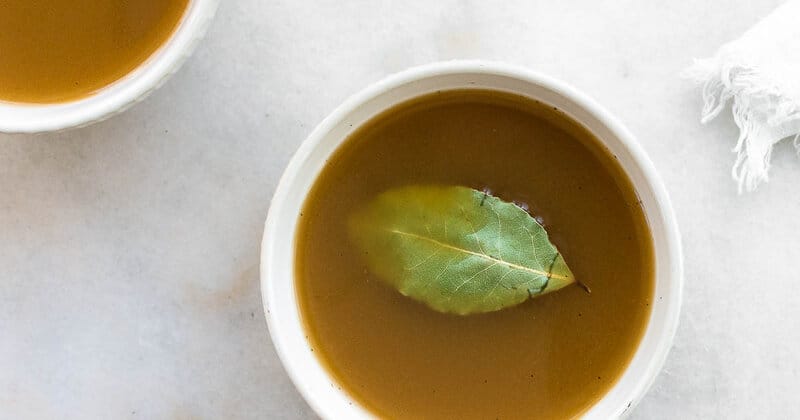Wholesome and deeply nourishing, bone broths are among the most affordable and nutritious foods you can make at home. Rich in protein with a deeply savory aroma and flavor, broth gives foundation to soups, stews and sauces. Even more, you can also sip them on their own as a restorative.
What is bone broth?
Bone broth is the liquid that is leftover after you simmer meaty bones and connective tissue in water for an extended period of time. In addition to bones, connective tissue and joints, bone broths often contain vegetables, herbs and spices as well as wine or apple cider vinegar.
Vegetables, herbs and spices give flavor bone broths, but sometimes cooks add medicinal herbs like reishi or ashwaganda to give broth unique therapeutic properties.
An acidic ingredient, like wine or apple cider vinegar, helps break down the protein in connective tissue and collagen to produce a gelatinous, protein-rich broth. And it’s that protein that you’re after when you drink broth.
While you can use it as a base for soups, stews sauces and gravies, it’s traditionally sipped on its own as a restorative food. That is, people traditionally sipped broths with the intention of mitigating an illness, like a cold, or to restore and maintain general health.
What’s the difference between broth, stock and bone broth?
Broth, stock and bone broth are similar foods. Further, cooks often exchange one for another easily in cooking, but there’s a few key differences between these three foods. Namely, broth, stock and bone broth are made in slightly different ways and used differently.
- Broth is typically made from meat and simmered a short while. Broths are light in flavor, and often sipped on their own as a restorative tonic.
- Stock is made from meaty joints and bones, simmered a moderate amount of time and cooks use them as the foundation of other foods like sauces, soups and stews.
- Bone broth is made from a variety meaty joints and bones, simmered for an extensive period of time, and typically sipped one its own as a restorative tonic.
Nutrition
Many people sip bone broth or begin making it at home, because they’ve heard that it may support digestion, fortify the immune system, or help reverse visible signs of aging. And while bone broth is an excellent source of collagen and a nutritious foods, its specific benefits are less clear.
- Bone broth is rich in a protein called gelatin, made from dissolved collagen. Collagen is found in connective tissue. While the amount of protein will vary depending on volume of water used, types of bones and length of cooking, most bone broth contains about 10 grams of protein per 8-oz serving.
- It’s also rich in the amino acids like glycine and proline. Glycine is an important neurotransmitter that has anti-inflammatory properties and supports the immune system (1). Proline, along with other key nutrients like vitamin C, helps to support healthy joint health and collagen production (2).
- Bone broth contains B vitamins like niacin and riboflavin, both of which play a role in metabolism. They also help your body break down carbohydrates, proteins and fats to produce energy. (3,4)
- Bone broth is rich in glucosamine and chondroitin, two nutrients that help support joint health. (5)
- Bone broth contains trace amounts of minerals, but, despite popular claims, it is not a good source of calcium, phosphorus or other minerals. Read more about bone broth and minerals here.
Which bones should you use for your broth?
Good bone broth gets its characteristic gelatinous structure from collagen. And collagen comes from the connective tissue in meat, ligaments, and on bones. So, for a good-flavored broth that’s also rich in protein and gelatin, select a wide variety of bones that include some joints as well as meaty bones.
- For beef bone broth and beef stock, use knuckle and neck bones, shanks and oxtails. You can also use marrow bones, too. But, be careful, as too much marrow makes for poor flavor, greasy texture and no gel.
- For chicken bone broth, use a whole chicken, chicken feet, the frame of a roasted chicken, or chicken backs and wing tips. You can even make it using only chicken feet.
- For turkey bone broth, use the frame of a roasted turkey, turkey backs, wing tips and feet, if you can find them.
- For pork, use ham hocks and pork neck bones. If you’re lucky enough to find them, you can also use pork trotters, too.
Tips for Making Bone Broth
Making bone broth is fairly straightforward and easy. And if you can turn on your oven, or boil a kettle of water, you can make good bone broth. Of course, there’s a few key tips you’ll want to pay attention to so that your broth comes out perfect every time.
How to Get Started
- Roast your bones first. Roasting bones caramelizes their proteins and releases some fat. And that means a richer and more robust flavor for you.
- Use wine for a touch of acidity. An acidic ingredient like wine helps to balance the flavors in bone broth, and gives better flavor than apple cider vinegar.
- Use enough water to just cover the bones, but not too much more. Bone broths achieve their gel and high protein content because they tend to use less water than the amount used for meat broths and traditional stocks.
- Spoon off any foam or scum that rises to the top, while it’s mostly made of protein and is fine to eat, it can make your broth cloudy and muddy the flavor.
How to Get a Good Gel
- Bring your kettle to a boil, and then immediately turn down the heat to a slow simmer. Simmering broth at a low temperature means better clarity, better flavor and a less greasy broth. The right temperature is also key in making sure your broth gels.
- Simmer bone broth for several hours, not days. Simmering your broth for too long may make the gelatin break down, and it can release histamines to which some people experience sensitivity. You’ll still get plenty of protein and loads of flavor with a shorter simmer. And you won’t waste energy in the process.
How to Develop Great Flavor
- Add medicinal and culinary spices at the beginning. Black pepper and tough, woody herbs like dried bay, and dried roots like astragalus need time to release their flavor so add them to the pot with your bones.
- Add roasted garlic and onions at the beginning. You can toss onion halves and garlic in with your bones when you roast them, and they’ll give your broth fantastic flavor.
- Add vegetables at the end. Vegetables like carrots and celery can give broth a lovely flavor. But, they can also make your broth taste overly sweet, tinny or like overcooked vegetables. And no one wants that! Add them in the last 20 to 30 minutes of cooking for the best flavor.
- Add leafy herbs at the end. Leafy herbs like parsley, savory and basil can give it a beautiful punch of flavor. Unfortunately, they’ll lose all their vibrance if added to early. So add them in the last 10 minutes of cooking, or right when you take the pot off the heat.
Finishing Your Broth
- Strain the hot broth into glass containers, and allow at least 1 inch of head space (or 2 if you plan to freeze the broth).
- Degrease your broth by letting it sit and spooning off any fat that floats to the surface. Or transfer it to the fridge, and the fat will rise to the surface and coagulate as it cools. Lift off the fat with a spoon or fork before you eat it to avoid a greasy, unpalatable broth.
How to Use All That Broth
Traditionally, people sip bone broths on their own or with herbs and a sprinkle of sea salt for flavor. In this way, they’re primarily served as a restorative. However, you can use them just as you would traditional stocks and meat broths, too.
- Sip bone broth on its own, or with a sprinkle of salt and a swirl of spices and herbs. It’s an excellent protein-rich snack or appetizer.
- Use it to make soups and stews, like Mushroom Stew, Turkey and Wild Rice Soup, or Potato Leek Soup.
- Use it to make sauces like gravy, pan sauce or reduction sauces.
- Cook rice or grains in bone broth for a boost of flavor and protein. It’s fantastic in mushroom risotto.
Basic Bone Broth Recipe
Prep Time5 mins
Cook Time8 hrs
Total Time8 hrs 5 mins
Servings: 8 servings (2 quarts)
Calories: 58kcal
Ingredients
- 3 pounds bones (chicken, beef, pork, lamb etc.)
- 2 tablespoons extra virgin olive oil
- 1 cup white wine
- 12 cups water
- 2 bay leafs
- 1 tablespoon black peppercorns
- fine sea salt
Instructions
- Heat the oven to 400 F, and line a baking sheet with parchment paper.
- Arrange the bones on the baking sheet, and drizzle with extra virgin olive oil. Next, roast them for 30 minutes, or until slightly brown. Turn half-way through to promote even cooking.
- Using a pair of kitchen tongs, transfer the bones to a heavy stock pot. And then pour in the wine and water. Drop in the bay leaves and peppercorns.
- Bring the pot to a boil over medium-high heat, and then immediately turn the heat down to low. Simmer, uncovered, at least 8 hours and up to 16 hours. Skim any foam that appears at the surface of the broth.
- Strain the broth, and season it with fine sea salt as you like it. Serve immediately, or pour it into jars and store in the fridge up to 1 week and in the freezer up to 6 months.
Notes
On Your Timing: Chicken bones and other small bones take less time, and large bones like beef bones require a longer simmer.
Nutrition
Calories: 58kcal | Carbohydrates: 1g | Protein: 10g | Sodium: 91mg | Potassium: 21mg | Sugar: 1g | Calcium: 3mg | Iron: 0.1mg
Taking it to the next level.
If you really want to take your bone broth to the next level, check out these resources.
1) Zhong, Z., et al. (2003) L-Glycine: a novel antiinflammatory, immunomodulatory, and cytoprotective agent. Current Opinion in Clinical Nutrition and Metabolic Care.
2) Wu, G., et al. (2011). Proline and hydroxyproline metabolism: implications for animal and human nutrition. Amino acids.
3) Bradford, A. (2018) Niacin (Vitamin B3): Benefits & Side Effects. Live Science.
4) Bradford, A. (2015) Vitamin B2 (Riboflavin): Sources, Benefits and Dosage. Live Science.
5) Tang, H. & Pang, S. (2016) Proline Catabolism Modulates Innate Immunity in Caenorhabditis elegans. Cell Reports.
5) Toweed, T. et al. (2005) Glucosamine therapy for treating osteoarthritis. Cochrane Database of Systematic Reviews.


